November 29th, 2006
Behind the Marque
Nathan Laliberte explores the short
yet brilliant life of The Bizzarrini Auto Company
Photos by Nathan Laliberte
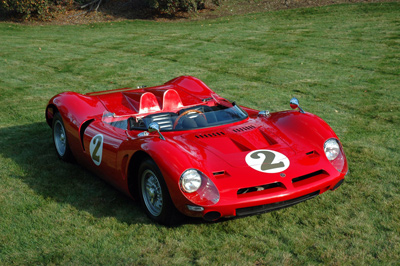
The dramatic lines on the P538 were a trademark of Bizzarrini design.
|
In the words of Oscar Wilde, �beauty is a form of
genius- is higher indeed, than genius, as it needs no
explanation.� For roughly seven years, Giotto
Bizzarrini produced some of the most striking and
innately beautiful cars of the Twentieth century.
Strangely, very few people who do not have strong
passions for automobiles have ever heard of
Bizzarrini, let alone the exquisite P538 or the
immortal 5300 GT. Is it not strange that such beauty in
design could be so unrecognized by the general public?
Vincent Van Gogh probably toiled over the same issue
as he only sold one painting during his poverty-
stricken life. It seems that discreet yet undeniable
brilliance is often overlooked in the face of
overwhelming popularity. The fact is that while
Bizzarrini enjoyed mild success and recognition, his
company never became the household names that Ferrari,
Lamborghini and Maserati are today. His factory in
Livorno, Italy produced sports cars of the highest
caliber for four years before going into receivership
in 1968 and finally, closing in 1969.
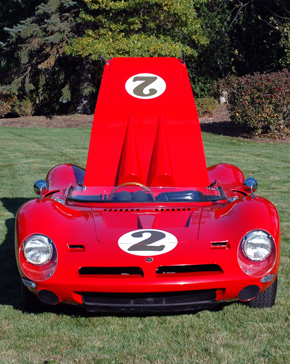
Livery--the number 2, copies the LeMans entry in 1966.
|
Giotto came from a family of engineers.
In 1954, he quit his University teaching job to pursue
a faster lifestyle as a test driver for Alfa
Romeo. By 1957, he had moved on to Ferrari where he
became head of controlling and testing for production
and also assisted in the development of the legendary 250 GT.
He then moved
to Lamborghini where he helped to modify their V-12
engine. Giotto then transitioned to Iso where he
worked closely with Renzo Rivolto in developing a
lineup of super cars. The relationship between Iso and
Bizzarrini quickly went south when Giotto began
applying his own logos on the hoods of the Iso A3/C
line. After a controversial departure, Giotto retained
the rights to build the A3/C under his own name.
This was the car that would eventually be known as the
5300 GT. In 1965, the Bizzarrini factory finally opened
and began producing automotive masterworks.
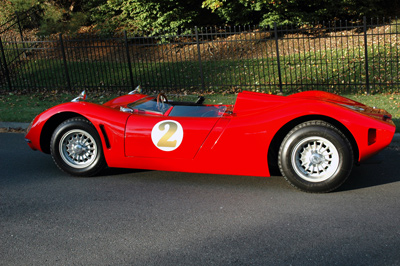
The p538 was capable of speeds nearing 200mph!
|
Today, Bizzarrinis are prized possessions in the
automotive world. Because so few were ever produced
(somewhere between 150 and 200), prices can easily
soar into the seven figures. The GT 5300 Stradale was
the most widely produced with about sixty-five
examples completed between 1965 and 1968. Crammed
behind the driver�s seat was a massive, 365 HP Chevy
V8. The aluminum body, designed by Bertone, came
complete with radiator cooling nostrils and push
button door releases. There is nothing like hearing
the sonorous click of a push button door release!
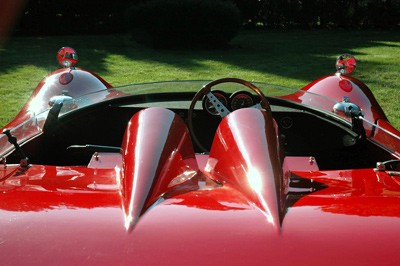
The stylish headrests do not have air intakes and were added to improve aerodynamics.
|
The
performance was fantastic. The �65 5300 GT
could leap to 60 MPH in 6.3 seconds and had a top
speed of 145 MPH. While the interior was sparsely
adorned, the raw power of the engine and dramatic
styling cues made up for many shortcomings in the
creature comfort department. This was not a car you
bought to enjoy the feel of supple Italian leather or
to take in a bucolic view of the countryside with your
Saturday night date. Customers paid top dollar to feel
the road in front of them and to sense a living and
breathing animal in their grasps. Driving a brand new
5300 GT was like sitting atop a bull and running it
down the cobble stoned streets of Pamplona. Bizzarrini
never made particularly comfortable automobiles,
rather, he crafted exquisitely designed beasts.
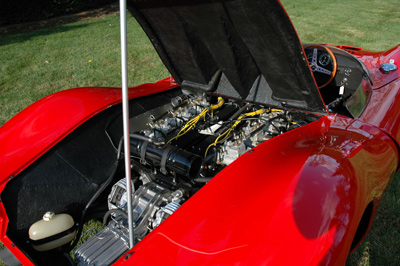
Lambo V12 engine with six down draft weber carburettors.
|
In the fall of '65, Bizzarrini completed work on his mid-engine
Chevy-powered sports prototype dubbed the P538. It could reach speeds
nearing 200 MPH and had an impressive 419 HP at a roaring
8300 RPM. The P538 was intended to bring Bizzarrini to
the zenith of the racing circuit declaring Giotto as a
force to be reckoned with. In June of 1966, the P538 entered
Le Mans with drivers Edgar Berney and Anre Wicky. Starting
40th on the grid, the P538 spun off the start line and was
then retired after three hours due to a cracked chassis
tube. Because of the constantly changing racing regulations,
the car became ineligible for the second half of the '66
season. In an attempt to generate cash flow, Bizzarrini modified
the P538 to a closed coupe style and made an unsuccessful
attempt at selling the failed Le Mans racer. From there, the
car took on a very interesting provenance that would
eventually lead to it ending up in Sweden as the one and
only Manta Concept car owned by Ulf Larssen.
In 1968, the chassis was given to the future head
of Italdesign, Giorgetto Giugiaro. He removed the P538 body
and replaced it with the ultra futuristic Manta body. The
car made its first appearance at The Turin Auto Show in
late 1968. It was then displayed in the U.S. whereafter it was
mysteriously lost on the sea voyage back to Europe. Roughly
five years later, the now aqua-green Manta was put on the
auction block as part of the Port of Genova Customs Auction.
A man from Cuneo, Italy by the name of Giovanni Giordanengo
snapped up the one-off concept for his private collection.
It remained with Giordanengo until October of '88 when it
was bought by Swedish collector, Ulf Larssen. It was
purchased just in time for Larssen to show the car at the 20th
anniversary celebration of Italdesign in Italy. The "sea
foam" green paint was changed to metallic silver, possibly
to give the car a more aggressive stance. As of '99, the car
was for sale by the Larssen family.
This is the kind of story that makes the Bizzarrini
marque so compelling. The '66 P538 was crafted not only by
Bizzarrini but also by the god of Italian car design,
Giorgio Giugiaro. Even without success at Le Mans, the
P538/Manta Concept will always remain a legend of automotive
ingenuity and a true piece of Italian history.
During the course of Giotto�s four year run, he
produced not only the 5300 GT and P538 models, but also
some lesser known models such as the Europa and ASA.
These were not particularly stunning cars but they still
retained the unmistakable flare of a Bizzarrini. The
question remains: How could such an innovative designer as
Bizzarrini go out of business in less than five years?
Without worldwide recognition from the race track and the low number
of production vehicles, Bizzarrini was forced to shut down his factory
for good. Giotto was never recognized as the preeminent
maker of Italy�s finest sports cars. Some would say he
is best known for his development of the Ferrari 250 GT.
A dubious honor considering the fact that his own Marque
achieved such brilliance in just four years.
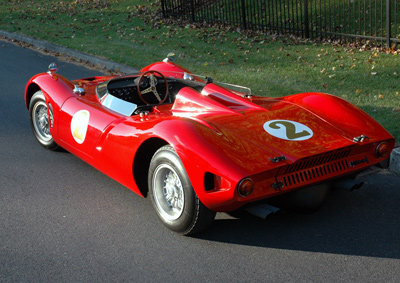
This P538 also features a five speed manual transmission, campognolo wheels and an all- fiberglass body.
|
The P538 featured here is currently part of the Van Horneff
Collection of Saddle River New Jersey.
This stunning example was purchased by Mr. Horneff at auction in 1996. Originally commissioned by a wealthy Torino jeweler, Luciano Bertolero, the car was designated chassis #002. According to Van Horneff, "it was initially built in 1966 to run as the Bizzarrini entree at Le Mans for 1967, then set aside
and not completed until 1972 because of the 1967-8 FIA's homologation rule changes."
The racer boasts the legendary Lamborghini V12 engine that Bizzarrini had helped to develop during his time as an engineer at Lamborghini. Chassis #002 also features a five speed manual transmission, campognolo wheels and an all fiberglass body. When Mr. Horneff started the engine in preparation for our ride around his neighborhood , the thunderous roar of the massive V12 jolted my senses. As we twisted and turned our way through the curved roads of New Jersey, I started to realize just how well the car was engineered. I rarely heard a bump or a creak and the handling was that of a modern day sports car. Gravitational forces seemed only to assist with performance instead of deter. Upon exiting the P538, my hair was blown and my eyes were tearing but I was still able to realize the engineering brilliance and utter pizazz appeal of the P538.



